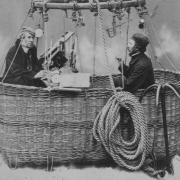You’ve heard of Amy Johnson and Amelia Earhart. Now hear about Pauline Gower. Pauline achieved so many amazing feats as a female aviator, she too should be a household name. And how tragic that this anything but an ordinary woman, who smashed so many barriers, would die at the age of just 36 after giving birth to twins.
When we talk of feminism, Pauline Gower was there at the forefront. From the wind-crushed, open-air cockpit of her plane she smashed through the glass ceiling that would lead to a whole new generation of female fliers.
Gower was born in 1910 – the last days of the Edwardian era- and grew up in Tunbridge Wells. Her father Sir Robert Gower was a Conservative MP for Gillingham, known for his animal welfare activism and his work with the RSPCA.
The family lived at Sandown Court and Pauline along with her sister Dorothy, was educated at the plush Beechwood Sacred Heart School. Here Pauline excelled at music and sport. She was a happy, spirited bundle of energy. It was said she climbed every tree within the school grounds.
At the age of 17 Pauline she became seriously ill and had to have a mastoidectomy - surgery to remove diseased cells in the hollow spaces in the skull behind the ear -which affected her health, particularly her lungs, for the rest of her life. The illness, however, did not blight her spirit or her quest for adventure.
Leaving school at 18, Gower did one season as a debutant (which bored her to tears). She was supposed to go to finishing school in Paris, but decided she needed a profession in which to earn her living.
Even at this age Gower was fascinated by flying. She once wrote about how she became enticed by aviation: 'I’m still interested in mythology, photography, riding to hounds – in fact, in everything, but at 19 my thoughts turned to flying and I decided to do it seriously. I was convinced that aviation was a profession with a future and determined to earn my living and make my career a paying proposition.'
Gower first began flying with celebrated English aviator Alan Cobham and earned her pilot’s licence in 1930 inside the cockpit of a De Havilland DH 60 Moth. As her career literally began to take off, Gower had designs on flying across the globe. At one point she wanted to fly to India, but her parents said no. To be fair, they were extremely supportive of her and although they put their foot down about this dangerous escapade, Gower respected their decision.
One of the most serendipitous moments in Gower’s life was when she met Dorothy Spicer at the Stag Lane Aerodrome in north London.
Spicer too an aviatrix- a wonderful pioneering pilot. She had been the first woman to gain an advanced qualification in aeronautical engineering. The pair became instant friends, and the friendship would be one of the most important in both of their lives.
In August of 1931 Gower and Spicer established their own joyriding and air taxi service in Kent. Gower was licensed to carry passengers for 'hire or reward’ and held a 'B' Pilot's licence after completing the test requirements which included a solo night flight and 100 hours of flying in the day.
Spicer, meanwhile, was qualified as a ground engineer and held an 'A' (private) pilot's licence. The pair hired a plane and later bought a Gypsy Moth for the business.
By 1935 Gower had taken 18,000 passengers for joy flights. In a newspaper interview she recounted some of the many characters she 'took up into the sky: “I once took up a grand old lady of 80,' said Gower.
'She was game for anything. The only trouble was her teeth. They were false and didn’t fit very well. Would I mind if she left them down below? She wasn’t scared of being hurt herself, she just couldn’t abide the idea of damaging her precious teeth!'
She added how one fellow she took up had an ulterior motive- he wanted to end it all. 'Once a potential suicide came for a flight,' she described. 'He made several attempts to stand up and climb out, but each time I managed to jerk him back into his seat.'
Then there was the time a ‘stowaway’ managed to get onboard her plane. 'In the middle of an acrobatic display, a small boy stowaway suddenly appeared beside me. Our surprise was mutual, however, because when we landed, he ran away to his mother, crying- oh mummy, he’s a girl!'
After struggling to make enough money through joy rides, Gower and Spicer joined the Crimson Fleet air circus and later the British Hospitals' air pageant.
To support British Hospitals, the pair toured the country as the ‘daring aeronauts’, giving air pageants in 200 towns.
Known as ‘the blonde pilot’ in the newspapers, Gower explained the adventure to a newspaper reporter in 1936: 'I’m a star in an air circus. For the next six months I shall lead the life of a nomad,' she said.
'The risks I run, the awkward moments which every pilot experiences, make my job the biggest thrill.
'Day after day I shall see new faces, find new experiences as my plane zooms through the blue sikes, dives to earth and climbs to the heavens- just to thrill the public.
'My partner in this adventure is Miss Dorothy Spicer the only fully licensed and practicing woman aircraft engineer in the World.
'We might be called the Romanys of the air and just like the Romanys of the road we wouldn’t exchange our life for any other.'
Air pageanting was obviously a dangerous business. In 1936 Gower was injured when her plane hit another on the runway at an air show in Coventry. She was taken to hospital with scalp lacerations and concussion.
Flying high on their success as the daring aeronauts, both women joined the Aeronautical Section of the Women's Engineering Society and Gower during this time, also wrote for Girl's Own Paper and Chatterbox and published a collection of poetry, Piffling Poems for Pilots, in 1934.
In 1936, Gower became the first woman to be awarded the Air Ministry's Second Class Navigator's Licence. Despite her expert skills in the cockpit, she was still having to explain herself as a female pilot: 'Some people believe women pilots to be a race apart and born ‘fully fledged’. Women are not born with wings, neither are men for that matter. Wings are won by hard work, just as proficiency is won in any profession’.'
Gower was very well connected thanks to her education, her father’s work as a MP and her mother’s social status. On the outbreak of the Second World War in 1939 she made use of her high-level connections to propose the establishment of a women's section in the new Air Transport Auxiliary —the ATA.
She got her way, and the unit would be responsible for ferrying military aircraft from factory or repair facilities to storage units or operational units.
Based at Hatfield, Hertfordshire, in the winter of 1939 Gower formed a ferry pool, initially made up of eight female pilots. Known as the ‘First Eight’ the women were Joan Hughes, Margaret Cunnison, Mona Friedlander, Rosemary Rees, Marion Wilberforce, Margaret Fairweather, Gabrielle Patterson and Winifred Crossley Fair. Later members included Amy Johnson (who would go onto the become one of the most famous female pilots of all time) and former Olympic skier Lois Butler.
During this period of her life, Gower was plagued by illness again. She got pneumonia and, on her doctors, advise went to Switzerland for a while to recuperate.
Gower was passionate that every woman should have the chance to pilot an aircraft and she made groundbreaking changes to the status of female pilots. She was able to argue that women in the ATA should be allowed to fly any type of aircraft.
In 1943 they also achieved pay parity with male pilots- before this women fliers had been paid around just 80 per cent of the men’s wage.
By the end of the war Gower was a famous name in Britain and was awarded with a MBE for her services to aviation. In 1945 she got married to Commander William Cusack "Bill" Fahie at the Brompton Oratory in London. Never one to confirm to the expected traditions, Gower wore a pale pink dress and a blue hat as she walked down the aisle.
This more grounded time in her life would not last. Less than two years later, on March 2, 1947, Gower died at her home in Chelsea, just hours after giving birth to twin sons, Paul and Michael. The babies survived. Gower was just 36.
Her funeral was held at St Augustine’s Church in Tunbridge Wells. A requiem mass was performed at her funeral and a host of aviation dignities attended. One person who was absent was her lifelong friend Dorothy Spicer.
This is because Dorothy had been killed in a plane crash near Rio de Janeiro in Brazil, just a few months earlier. Spicer -aged 38- was with her husband when the aeroplane there were on crashed into a mountainside, killing all 21 passengers.
Another well-known aviatrix who was a friend and colleague of both Gower and Spicer was Amy Johnson, known for being the first woman to fly solo from London to Australia.
Johnson once wrote: 'Pauline and Dorothy are two of my best friends. My admiration for the work they have done for aviation is unbounded.'
Alas, Amy Johnson too would end up dying at a tragically young age of 37. She famously disappeared over the Thames Estuary in January of 1941 while on a flying mission for the Air Ministry.
She was delivering an Airspeed Oxford plane from Prestwick via Blackpool to RAF Kidlington near Oxford. Weather conditions were poor, and Johnson was forced to bail out of her plane near Herne Bay. Even today the exact circumstances of her death remain a mystery.



























